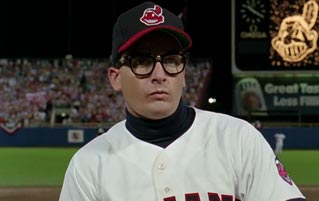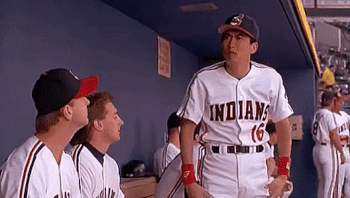How The 'Major League' Movies Predicted Modern Baseball

In Major League 2, the inferior but still endearing (if you watched it on basic cable 4,600 times in the '90s) sequel to the hit 1989 comedy Major League, the hapless Cleveland Indians trade away their best player to save money. In return, they receive the goofiest, most outlandish, slapstick-iest player anyone can imagine: a guy from the Japanese baseball league.
His name is Hiroshi "Kamikaze" Tanaka, and he's a reckless screwball who earns his nickname by constantly crashing into walls and knocking himself unconscious. He also taunts fellow outfielder Pedro Cerrano for not having the spirit of a "warrior," and butchers some broken-English attempts to say he has no testicles.

One year later, in 1995, the real-life Los Angeles Dodgers signed Hideo Nomo, a pitcher from the Japanese league, who immediately went on to make the All-Star Team and won Rookie of the Year. This opened the door for the now-common trend of MLB teams signing Japanese pros, which has since yielded surefire Hall of Famer Ichiro Suzuki, Yankees 2-time All-Star and '09 World Series MVP Hideki Matsui, and current Angels' hitting and pitching phenom Shohei Ohtani, among others. Essentially, the dumbest thing the screenwriters of Major League 2 could dream up in 1994 became an incredibly forward-thinking trend that teams league-wide have since rushed to emulate.
But the strangely prescient predictions of Major League and Major League 2 don't stop there. (Sorry, we're not counting Major League: Back To The Minors, a movie so forgotten that you didn't know it existed until this parenthetical.) And they're not all for the better. The movies foresaw a whole host of sad, ominous trends that would eventually engulf America's national pastime. If only we'd known at the time ...
Related: 27 Mind-Blowing Things Accurately Predicted By Movies
Charlie Sheen Took Steroids To Play A Fake Baseball Player
In a 2011 interview, Charlie Sheen revealed that he took steroids for "six to eight weeks" while filming the original Major League. He claims the drugs helped juice his fastball from 79 to 85 mph. While this may have just been a roundabout way of bragging that he could throw 85, he still risked testicular shrinkage to throw a ball unnoticeably faster in a goofy '80s comedy, which is some straight up DiCaprio Revenant-level "leak the anecdote to help your Oscar case" shit.

Now, if in 1989, Sheen knew to take steroids to play baseball better, and then easily acquired them and did instantly play better, surely everyone else who played (and covered) baseball would've known?
In 1998, Mark McGwire and Sammy Sosa drove a resurgence in baseball's popularity when they obliterated the single-season home run record, smacking the two highest home run totals in the hundred-year-plus history of the sport. The baseball press turned a blind eye to the swole, roided-out elephant in the locker room, then retroactively acted shocked when an Easter-Island-craniumed Barry Bonds re-broke the record with 73 homers at age 36. A subsequent doping scandal led to sport-wide hand-wringing, a strict overhaul of the league's drug policy (which didn't technically exist before 2005), and literal congressional hearings.
These baseball writers and executives instantly morphed into some hybrid of furious hellfire morality preachers and wealthy dowagers collapsing onto fainting couches when they learned that some athletes might be taking advantage of baseball's nonexistent drug testing program to earn millions more dollars. But do we really believe they knew less about steroids than a bad-boy actor playing a bad-boy pitcher in an '80s movie? 15 years after Major League, a bunch of guys who stood five feet away from baseball players 200 days a year acted less lucid about the reality of the sport than '80s Charlie Sheen.
Related: The 5 Most Ridiculous Pop Culture Predictions That Came True
Every Owner Is Rachel Phelps Now
In Major League, the evil, scheming Rachel Phelps takes control of the Indians and deliberately guts the payroll and all other expenses to the bare minimum so the team will do poorly enough for her to move the franchise to Florida. She doesn't care about the fans, and she definitely doesn't care about winning -- she only cares about wringing every dollar for herself. She takes it to such a cartoonishly evil degree that it ends up uniting the players and motivating them toward a miraculous division title.
In 2019, that's ... not really any different from what most baseball owners are doing. The Miami Marlins absolutely squeezed Miami-Dade County for $500 million in taxpayer money to build a new stadium in 2012 (which might end up costing residents well into the billions over time). They haven't had a winning season since, cut $47 million from their payroll last year, and now play in an empty stadium to smatterings of depressed die-hard fans, just like in Major League:

Obviously, baseball owners being selfish isn't new. Charlie Finley, the owner of the Oakland A's team that won three straight World Series in the '70s, forced his employees to follow a complex phone-usage protocol to keep his team's phone bill under $30. But this recent bout of league-wide extreme cheapness comes at a time when Major League Baseball has posted record-breaking revenues for the 16th consecutive year.
Yet the owners, who are richer than ever (and often nothing but vague private investment groups with no real public "face"), continue to extort money from local governments to subsidize entirely unnecessary stadiums. Atlanta just built a new $1.1 billion stadium, even though their previous park opened in 1997. Are there even any other buildings still standing from that ancient era?
The Braves did make the playoffs last year, though. Maybe they were motivated by a naked cardboard cutout of their owner, the ultra-sexy Liberty Media Corporation.

Related: 21 Eerily Specific Pop Culture Predictions That Came True
Ads In The Outfield? Preposterous!
In Major League 2, ex-player Roger Dorn buys the team, but quickly goes broke and has to scramble to raise money however he can. So he does the most shameless, sleazy, exaggeratedly desperate move the screenwriters could cook up: He plasters the outfield wall with a bunch of ads. The players emerge from the dugout and gawk at the branded monstrosity, and manager Lou Brown quips, "Aw, what the hell is this crap?"

The joke doesn't land when you watch the movie today. After all, every MLB stadium's outfield is slathered in ads. Scoreboards have ads over every inch of them, rotating ads are green-screened behind home plate for the TV audience, and every stadium in every professional sport is named after a corporate sponsor, usually for a nine-figure payout.

Roger Dorn wasn't some pathetic, shameless sellout; he was way ahead of the curve when it came to tapping alternative revenue streams. Not to mention the 20-minute scene in which he describes the value of geo-tagged sponsored Instagram posts ...
Related: 5 Eerie Predictions By TV Shows That Totally Came True
Major League 2 Replaced Wesley Snipes With A Younger, Cheaper Actor
Wesley Snipes, who played Willie "Mays" Hayes in the first Major League, became a massive A-list star in the early '90s and didn't have much interest in returning to a PG-ified comedy sequel with an ensemble cast in 1994. So the filmmakers simply replaced him with Omar Epps and put the movie out anyway.

This portended the biggest dilemma MLB players face today: Outside of a couple of mega-elite superstars, veteran free agents simply aren't getting signed anymore, or are signing for way less money than they used to. Younger players are much cheaper, and front offices have no real interest in spending money on vets when the added "being better at baseball" from that player just earns teams on-field wins rather than financial ones. Even big spenders like the Yankees are now only paying about 30 percent of their total revenue in player expenses; in 2004, that number was closer to 85 percent.
Younger and cheaper is the name of the game. Even if Omar Epps only gives you 60 percent of Wesley Snipes' production, if he's a hundredth the cost, any owner -- sorry, studio -- is gonna take that tradeoff. Even within the world of the movie, poor Roger Dorn went from being a veteran star player who can't wait to hit free agency in Major League to a complete joke who gets one plate appearance all season so he can step into a pitch in the sequel. Was this just a convenient plot hole the movie overlooked because they wanted turn him into a worthless dunce? Or was it a CHILLING SIGN OF BASEBALL ECONOMICS TO COME?
If only the players, fans, and writers had truly read between the lines of these two seemingly slapstick comedies from decades ago. We could've been prepared for the steroid epidemic, soaring owner greed, and the collapse of baseball's labor market. And while we're on the subject, don't even get us started on how the kid manager from Little Big League was light years ahead of the curve on infield shifts ...
Dan Hopper is an editor for Cracked. You can read his consistently A-minus Tweets at @DanHopp or hear his excellent takes in audio form on The Cracked Podcast.
Support our site with a visit to our Contribution Page. Please and thank you.
For more, check out The Case For Taking Drugs In Sports:
The first-ever Cracked Podcast LIVE TOUR is coming to a city near (some of) you this spring! Tickets on sale now for Chicago IL (April 11th) and St. Paul MN (April 12th).
Following us on Facebook is a treasured pastime.